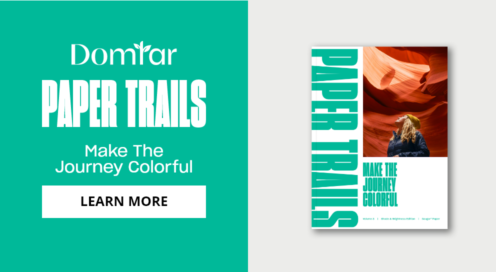Colour my life… a designer’s guide to colour resources
Written by John Furneaux RGD
Both instructive and constructive, colour is one of the most important elements in design. In branding, it serves as a tool for both brand recognition and to convey attributes. In communications, it helps to lead our eyes and bring focus. But too often, people make colour choices based on what they “like” rather than for more objective reasons.
What follows is a list of resources and tools that designers can use to increase their knowledge around specific colour use and implications. Many of these resources can also be used to help educate a designer’s clients on why certain colours are either recommended or may not be appropriate for use in a particular instance.

Introduction to Colour Theory
Value, hue, chroma, saturation, gamut—these are all much more than sliders in Adobe Photoshop. Understanding what each of these terms means and how they impact design is essential. If you ask us older designers what shaped our understanding of colour, we’ll tell you that it comes down to two textbooks that we used in design school: Interaction of Color by Josef Albers and Elements of Color by Johannes Itten.
In Interaction of Color, Josef Albers observed that one’s visual perception of colour is almost never the “factual colour” — making it the most relative medium in art. He said, “In order to use colour effectively, it is necessary to recognize that colour deceives continually. To this end, the beginning is not a study of colour systems.” In place of systems, Josef developed an “experimental way of studying colour and teaching colour,” a method based on the idea that “only by observing colour in the push and tug and pull of context can one begin to understand the nature of colour.”
In Elements of Color, Johannes Itten identifies seven fundamental categories of contrast: hue, light-dark, cold-warm, complementary, analogous, saturation and extension. He then developed several colour star models. You can read about and see these models through the following links:
- https://www.getty.edu/research/exhibitions_events/exhibitions/bauhaus/new_artist/form_color/
- https://www.movavi.io/color-wheel-en/
For those new to the world of working with colour, or even those looking to understand it further, a good place to start is Sean Adams’ book on working with colour, The Designer's Dictionary of Color. In addition, you can also take his online course, Introduction to Color Theory for Visual Communication, to deepen your knowledge of colour and learn how to use it to enhance your message. To help bring this to life and put theory into practice, he then guides you through creating your own poster design.

Using Colour Strategically
Stories About Colour
RGD Emeritus Bob Hambly publishes a blog that tells the stories around various colours and helps make connections on why we associate colours with various ideas and items. Bob recently gathered many of these stories in his book Pink Flamingos & Yellow Pages.
Another book filled with equally fascinating stories about colour is ROY G. BIV: An Exceedingly Surprising Book About Color.
These resources will help you better understand why your clients may see a colour choice differently —as well as help you clean up at the next RGD trivia night.
Interpreting Colour
Countries like Canada are made up of people from around the world, so whether the brand you’re working on has a global reach or a national one, understanding how different cultures perceive and interpret colours is essential. You can find an online overview here.
For a deeper dive into the subject, check out Naomi Kuno's book Colorscape: An Around-the-World Guide to Color provides a more in-depth analysis.
Colour Inspiration
The visual arts are always a great way to look for insight and inspiration for using colour. Understanding the emotions and feelings that artists were looking to convey through colour can open up new ways for considering how to use colour, as a designer. Learn more about colour inspiration with A Brief History of Color in Art by Sarah Gottesman.

Using Colour Conceptually
Colour Psychology
While the psychology of colour may be somewhat subjective and is influenced by cultural perspectives, more and more information continues to be amassed on this subject. Some interesting introductions to the topic can be found at:
- imjustcreative.com/psychology-of-color-chart/2016/11/28
- www.smashingmagazine.com/2010/01/color-theory-for-designers-part-1-the-meaning-of-color/
The Science of Colour
Artists who use colour extensively in their work provide an opportunity to gain insight from their experiences and explorations on this topic within their work. For example, Icelandic-Danish artist Olafur Eliasson uses the science and power behind colour and optical illusion to create an immersive experience to drive visceral, emotional reactions from viewers. See his artwork projects, The Weather Project and The Yellow Room.

Techniques and Tools for Using Colour
Colour Implementation and Management Basics
Don’t know your RGB from your CMYK? A good, straightforward introduction to the different colour modes, as well as when and how they can be used, can be found in this article on The Noun Project.
And what about RGB, sRGB HEX and LAB? An important aspect of using colour on the web is understanding the different colour formats available and how to use them effectively. Learn about colour formats on Atmos.
Creating Colour Themes
There are a variety of tools that allow you to generate colour themes based on a number of different colour theories. You can explore a range of colour harmonies on wheels to generate the most appropriate colour palettes for your design or application.
Accessibility Tools
Colour accessibility enables people with visual impairments or colour vision deficiencies to interact with digital experiences in the same way as the non-visually impaired. An estimated 217 million people live with some form of moderate to severe vision impairment. That statistic alone is reason enough to design for accessibility.
An accessible colour palette on the web means meeting the contrast ratios designated in the WCAG guidelines.
The tools below will check your colour values against each other.
If a branding project centres around its packaging, looking at colour from paper swatches could be a different way to start your palette. Oftentimes, designers create colour palettes digitally to start, then struggle to find the right CMYK to match. One option is to use the colour of the paper as a key piece of your design’s foundation. Neenah Papers has a tool, Adobe Swatch Exchange Files, that allows you to design and simulate the colours of their paper stocks.
Colour Systems
Love them or hate them as company, Pantone provides a consistent universal language of colour that enables critical decisions through every stage of the design and production process. The Pantone Matching System (PMS) now specifies almost 10,000 colours and provides a reference point for every single one, in both printed and digital formats. Unfortunately, Adobe Creative Suite no longer automatically supports the Pantone colour libraries; you need to subscribe to Pantone Connect to access them.
Ever since I was a young designer, I have loved the Toyo color system. Toyo is a Japanese ink manufacturer that offers alternative spot colours to the Pantone Matching System. Its 1,050 ink colour formulations are arranged on the Munsell colour model and are available in the colour libraries within Adobe Creative Suite at no additional cost.
Note:UK and US spelling of the word “colour” are used depending on the resource’s country of origin.
John Furneaux RGD
John Furneaux RGD is the Managing Director for the Toronto office of PS&Co Brand Studio, working with good organizations, to unify brand, people and purpose. For over 30 years, John has worked closely with organizations of all sizes — from entrepreneurial start-ups to global leaders. His award-winning experience spans a broad range of brand image and identity programs, as well as the communications and marketing initiatives that bring brands to life. John also teaches at George Brown College in their Design Management Program. He is a Past President of RGD and is an active speaker and contributor in the design industry.
Tag
Related Articles


John Furneaux RGD


John Furneaux RGD










